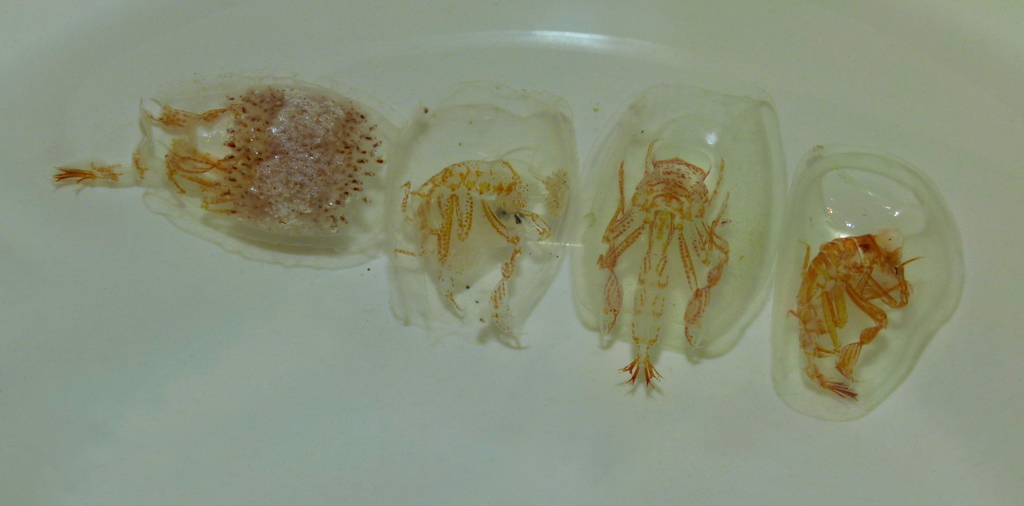Phronima Colletti on:
[Wikipedia]
[Google]
[Amazon]
 ''Phronima'' is a genus of small,
''Phronima'' is a genus of small,
Google search for images of Phronima
Hyperiidea Amphipod genera Taxa named by Pierre André Latreille {{amphipod-stub
 ''Phronima'' is a genus of small,
''Phronima'' is a genus of small, deep sea
The deep sea is broadly defined as the ocean depth where light begins to fade, at an approximate depth of or the point of transition from continental shelves to continental slopes. Conditions within the deep sea are a combination of low tempe ...
hyperiid
The Hyperiidea is one ot the six suborders of amphipods, small aquatic crustaceans. Unlike some other suborders of Amphipoda, hyperiids are exclusively marine and do not occur in fresh water. Hyperiids are distinguished by their large eyes and ...
amphipod
Amphipoda () is an order of malacostracan crustaceans with no carapace and generally with laterally compressed bodies. Amphipods () range in size from and are mostly detritivores or scavengers. There are more than 10,700 amphipod species cur ...
s of the family Phronimidae
The Phronimidae are a family of amphipod crustacean
Crustaceans (from Latin meaning: "those with shells" or "crusted ones") are invertebrate animals that constitute one group of arthropods that are traditionally a part of the subphylum Crustace ...
. It is found throughout the world's oceans, except in polar region
The polar regions, also called the frigid zones or polar zones, of Earth are Earth's polar ice caps, the regions of the planet that surround its geographical poles (the North and South Poles), lying within the polar circles. These high latitu ...
s. ''Phronima'' species live in the pelagic zone
The pelagic zone consists of the water column of the open ocean and can be further divided into regions by depth. The word ''pelagic'' is derived . The pelagic zone can be thought of as an imaginary cylinder or water column between the sur ...
of the deep ocean. Their bodies are semitransparent. Although commonly known as parasites, they are more technically correctly called parasitoids
In evolutionary ecology, a parasitoid is an organism that lives in close association with its host (biology), host at the host's expense, eventually resulting in the death of the host. Parasitoidism is one of six major evolutionarily stable str ...
. Instead of constantly feeding on a live host, females attack salp
A salp (: salps, also known colloquially as “sea grape”) or salpa (: salpae or salpas) is a barrel-shaped, Plankton, planktonic tunicate in the family Salpidae. The salp moves by contracting its gelatinous body in order to pump water thro ...
s, using their mouths and claws to eat the animal and hollow out its gelatinous shell. ''Phronima'' females then enter the barrel and lay their eggs inside, then propel the barrel through the water as the larvae develop, providing them with fresh food and water.
It is sometimes thought to be an inspiration for the fictional xenomorphs
The xenomorph (also known as a Xenomorph XX121, ''Internecivus raptus'', ''Plagiarus praepotens'', or simply the alien or the creature)Alien: The Weyland-Yutani Report is a fictional parasitoid, endoparasitoid Extraterrestrials in fiction, extra ...
.
''Phronima'' species possess unique compound eyes adapted to detect blue-green wavelengths of light, which are prominent in the bioluminescent flashes of potential prey and predators. These specialized visual adaptations aid Phronima in navigating the dim mid-ocean environment, where bioluminescence serves as an important ecological signal.
Classification
The genus ''Phronima'' contains these 10 species: *''Phronima atlantica
''Phronima'' is a genus of small, deep sea hyperiid amphipods of the family Phronimidae. It is found throughout the world's oceans, except in polar regions. ''Phronima'' species live in the pelagic zone of the deep ocean. Their bodies are semitra ...
''
*'' Phronima bowmani''
*'' Phronima bucephala''
*'' Phronima colletti''
*''Phronima curvipes
''Phronima'' is a genus of small, deep sea hyperiid amphipods of the family Phronimidae. It is found throughout the world's oceans, except in polar regions. ''Phronima'' species live in the pelagic zone of the deep ocean. Their bodies are semitra ...
''
*''Phronima dunbari
''Phronima'' is a genus of small, deep sea hyperiid amphipods of the family Phronimidae. It is found throughout the world's oceans, except in polar regions. ''Phronima'' species live in the pelagic zone of the deep ocean. Their bodies are semitra ...
''
*''Phronima pacifica
''Phronima'' is a genus of small, deep sea hyperiid amphipods of the family Phronimidae. It is found throughout the world's oceans, except in polar regions. ''Phronima'' species live in the pelagic zone of the deep ocean. Their bodies are semitra ...
''
*''Phronima sedentaria
''Phronima sedentaria'' is a species of amphipoda, amphipod crustaceans found in oceans at a depth of up to . They are large in size relative to other members of the family Phronimidae. Individuals may be found inside barrel-like homes, created m ...
'' (type species
In International_Code_of_Zoological_Nomenclature, zoological nomenclature, a type species (''species typica'') is the species name with which the name of a genus or subgenus is considered to be permanently taxonomically associated, i.e., the spe ...
)
*''Phronima solitaria
''Phronima'' is a genus of small, deep sea hyperiid amphipods of the family Phronimidae. It is found throughout the world's oceans, except in polar regions. ''Phronima'' species live in the pelagic zone of the deep ocean. Their bodies are semitra ...
''
*''Phronima stebbingi
''Phronima'' is a genus of small, deep sea hyperiid amphipods of the family Phronimidae. It is found throughout the world's oceans, except in polar regions. ''Phronima'' species live in the pelagic zone of the deep ocean. Their bodies are semitra ...
''
References
7. Osborn, K.J., Baldwin Fergus, J. (2020). Hyperiid Amphipod Adaptations to Mid-Ocean Environments. Smithsonian Ocean. National Museum of Natural History.External links
Google search for images of Phronima
Hyperiidea Amphipod genera Taxa named by Pierre André Latreille {{amphipod-stub